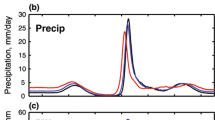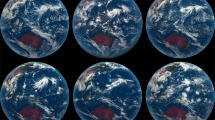Abstract
A high resolution general circulation model has been used to study intense tropical storms. A five-year-long global integration with a spatial resolution of 125 km has been analysed. The geographical and seasonal distribution of tropical storms agrees remarkably well with observations. The structure of individual storms also agrees with observations, but the storms are generally more extensive in coverage and less extreme than the observed ones. A few additional calculations have also been done by a very high resolution limited-area version of the same model, where the boundary conditions successively have been interpolated from the global model. These results are very realistic in many details of the structure of the storms including simulated rain-bands and an eye structure. The global model has also been used in another five-year integration to study the influence of greenhouse warming. The sea surface temperatures have been taken from a transient climate change experiment carried out with a low resolution coupled ocean-atmosphere model. The result is a significant reduction in the number of hurricanes, particularly in the Southern Hemisphere. Main reasons for this can be found in changes in the largescale circulation, i.e. a weakening of the Hadley circulation, and a more intense warming of the upper tropical troposphere. A similar effect can be seen during warm ENSO events, where fewer North Atlantic hurricanes have been reported.
Access this chapter
Tax calculation will be finalised at checkout
Purchases are for personal use only
Preview
Unable to display preview. Download preview PDF.
Similar content being viewed by others
References
Bengtsson, L., Botzet, M., and Esch, M., 1995. Hurricane-type vortices in a general circulation model. Tellus, 47A, 175–196.
Bengtsson, L., Botzet, M., and Esch, M., 1996a. Will greenhouse gas-induced warming over the next 50 years lead to higher frequency and greater intensity of hurricanes? Tellus, 48A, 57–73.
Bengtsson, L., Arpe, K., Roeckner, E., and Schulzweida, U., 1996b. Climate predictability experiments with a general circulation model. Climate Dynamics, 12, 261–278.
Brinkop, S., 1991. Inclusion of cloud processes in the ECHAM PBL parameterization. In: R. Sausen (ed.): Studying Climate with the ECHAM Atmospheric Model Large Sale Atmospheric Modelling, Report No. 9, 5-14, Meteorologisches Institut, Universitat Hamburg.
Brinkop, S., 1992. Parameterisierung von Grenzschichtwolken fur Zirkulationsmodelle. Berichte aus dem Zentrumfiir Meeres- und Klimaforschung, Reihe A. Meteorologie, Nr. 2, Meteorologisches Institut der Universitat Hamburg, 77 pp.
Broccoli, A.J. and Manabe, S., 1990. Can existing climate models be used to study anthropogenic changes in tropical cyclone climate? Geophysical Research Letters, 17, 11, 1917–1920.
Christensen, J.H. and van Meijgaard, E., 1992. On the construction of a regional atmospheric climate model. DMI Technical Report, 92-14.
Committee on Earth Sciences, 1989. Our Changing Planet: The FY1990 Research Plan. Office of Science and Technology Policy, Washington, D.C., 183 pp.
Conover, W.J., 1980. Practical Non-parametric Statistics. 2nd ed. John Wiley & Sons, New York.
Cubasch, U., Hasselmann, K., Höck, H., Maier-Reimer, E., Mikolajewicz, U., Santer, B., and Sausen, R., 1992. Time-dependent greenhouse warming computations with a coupled ocean-atmosphere model. Climate Dynamics, 8, 55–69.
Dell’Osso, L. and Bengtsson, L., 1985. Prediction of a typhoon using a fine-mesh NWP model. Tellus, 37A, 97–105.
Dümenil, L. and Todini, E., 1992. A rainfall-runoff scheme for use in the Hamburg GCM. In: Advances In Theoretical Hydrology: A tribute to James Dooge, J.P. O’Kane (ed.), European Geophysical Society Series on Hydrological Sciences, 1, Amsterdam: Elsevier 129–157.
Emanuel, K.A., 1986. An air-sea interaction theory for tropical cyclones, part I: Steady state maintenance. Journal of Atmospheric Science, 43, 585–604.
Emanuel, K.A., 1988. Toward a General Theory of Hurricanes. American Scientist, 371–379
Evans, J., 1992. Comments on: Can existing climate models be used to study anthropogenic changes in tropical cyclone climate. Geophysical Research Letters, 19, 14, 1523-1524.
Frank, W.M., 1977. The structure and energetics of the tropical cyclone, Paper I: Storm structure. Monthly Weather Review, 105, 1119–1135.
Gray, W.M., 1979, Hurricanes: Their Formation, Structure and Likely Role In the Tropical Circulation. Meteorology over the Tropical Oceans. D.B. Shaw(ed.), Royal Meteorological Society, London, 155–218.
Gray, W.M., 1988. Environmental influences on tropical cyclones. Australian Meteorological Magazine, 36, 127–139. Climatological Perspectives 89
Gray, W.M., 1989. Background information for assessment of expected Atlantic hurricane activity for 1989. 11th Annual National Hurricane Conference, Miami, NOAA, 41 pp.
Gray, W.M., Sheaffer, J.D., and Landsea, C.W., 1996. Climate trends associated with multidecadal variability of Atlantic hurricane activity, (Chapter 2, this volume).
Gustafsson, N., 1993. HIRLAM2 Final report. HIRLAM Tech. Report No. 9. SMHI, Norrkoeping, Sweden.
Haarsma, R.J., Mitchell, J.F.B., and Senior, C.A., 1992. Tropical Disturbances in a GCM. Climate Dynamics, 8, 247–257.
Hawkins, H.F. and Imbembo, S.M., 1976. The structure of a small, intense hurricane, Inez 1966. Monthly Weather Review, 104, 418–442.
Hense, A., Kerschgens, M., and Raschke, E., 1982. An economical method for computing radiative transfer in circulation models. Quarterly Journal of the Royal Meteorological Society, 108, 231–252.
Idso, S.B., 1989. Carbon Dioxide and Global Change: Earth in Transition. Tempe, AZ: IBR Press, 292 pp.
Idso, S.B., Balling, R.C., Jr. and Cerveny, R.S., 1990. Carbon dioxide and hurricanes: Implication of Northern Hemispheric warming for Atlantic/Caribbean storms. Earth in transition. Meteorological Atmospheric Physics, 42, 259–263.
IPCC, 1990. Climate Change, The IPCC Scientific Assessment. HoughtonJ., G.J. Jenkins and J.J. Ephraums (eds.), Cambridge University Press, Cambridge, 364 pp.
IPCC, 1992. Climate Change, The Supplementary Report to the IPCC Scientific Assessment, Houghton J., Callandar B.A., and Varnay S.K., (eds.), Cambridge University Press, Cambridge, 198 pp.
IPCC, 1995. Climate Change 1995, The Science of Climate Change, Houghton J.T., Meira Filho L.G., Callander B.A., Harris N., Kattenberg A., and Maskell K. (eds.), Cambridge University Press, Cambridge 572 pp.
JSC, 1980. Catalogue of numerical atmospheric models for the First GARP Global Experiment, Part I, 287-340, ICSU/WMO, Joint Scientific Committee, Geneva, April 1980.
Kurihara, Y. and Tuleya, R.E., 1981. A numerical simulation study on the genesis of a tropical storm. Monthly Weather Review, 109, 1629–1653.
Louis, J.F., 1979. A parametric model of vertical eddy fluxes in the atmosphere. Boundary Layer Meteorology, 17, 187–202.
Machenhauer, B., 1988. The HIRLAM Final report. HIRLAM Technical Report No. 5. DMI, Copenhagen, Denmark.
Manabe, S., Holloway, H.L., Jr. and Stone, H.M., 1970. Tropical circulation in a timeintegration of a global model of the atmosphere. Journal of Atmospheric Science, 27, 580–613.
Miller, M.J., Palmer, T.N., and Swinbank, R., 1989. Parameterization and influence of subgrid scale orography in general circulation and numerical weather prediction models. Meteorological Atmospheric Physics, 40, 84–109.
Neumann, C.J., Jarvinen, B.R., McAdie, C.J., and Elms, J.D., 1992. Tropical cyclones of the North Atlantic Ocean, 1971-1992. Asheville, NC, November 1993 (4th revision), 193 pp.
Palmer, T.N., Shutts, G.J., and Swinbank, R., 1986. Alleviation of a systematic westerly bias in general circulation and numerical weather prediction models through an orographic gravity wave drag parameterization. Quarterly Journal of the Royal Meteorological Society, 112, 1001–1031.
Ramanathan, V. and Collins, W. 1991. Thermodynamic regulation of ocean warming by cirrus clouds deduced from observations of the 1987 El Nino. Nature, 351, 27–32.
Rockel, B., Raschke, E., and Weynes, B., 1991. A parameterization of broad band radiative transfer properties of water, ice and mixed clouds. Betrieb Physiches Atmosphere, 64, 1–12.
Roeckner, E., Arpe, K., Bengtsson, L., Brinkop, S., Diimenil, L., Esch, M., Kirk, E., Lunkeit, F., Ponater, M., Rockel, B., Sausen, R., Schlese, U., Schubert, S., and Windelband, M., 1992. Simulation of the Present-day Climate with the ECHAM Model Impact of Model Physics and Resolution. Max-Planck-Institut fur Meteorologie, Hamburg, Report No. 93.
Roeckner, E., Rieland, M., and Keup, E., 1991. Modelling of cloud and radiation in the ECHAM model. ECMWFAVCRP. “Workshop on clouds, radiative transfer and the hydrological cycle”, 12-15 Nov. 1990, 199-222, ECMWF, Reading, U.K.
Schneider, S.H., 1990. Global Warming. Are We Entering the Greenhouse Century? Vintage Books, New York, 343 pp.
Shun, C.M., 1992. Performance of the ECMWF Model in Tropical Cyclone Track Forecasting over the Western North Pacific during 1990-1991, ECMWF Technical Memorandum No. 184A.
Sundqvist, H., 1978. A parameterization scheme for non-convective condensation including prediction of cloud water content. Quarterly Journal of the Royal Meteorological Society, 104, 677–690.
Tiedtke, M., 1989. A comprehensive mass flux scheme for cumulus parameterization in large-scale models. Monthly Weather Review, 117, 1779–1800.
Wu, G. and Lau, N.C., 1992. A GCM simulation of the relationship between tropical storm formation and ENSO. Monthly Weather Review, 120, 958–977.
Author information
Authors and Affiliations
Editor information
Editors and Affiliations
Rights and permissions
Copyright information
© 1997 Springer-Verlag Berlin Heidelberg
About this chapter
Cite this chapter
Bengtsson, L., Botzet, M., Esch, M. (1997). Numerical Simulation of Intense Tropical Storms. In: Diaz, H.F., Pulwarty, R.S. (eds) Hurricanes. Springer, Berlin, Heidelberg. https://doi.org/10.1007/978-3-642-60672-4_4
Download citation
DOI: https://doi.org/10.1007/978-3-642-60672-4_4
Publisher Name: Springer, Berlin, Heidelberg
Print ISBN: 978-3-642-64502-0
Online ISBN: 978-3-642-60672-4
eBook Packages: Springer Book Archive




